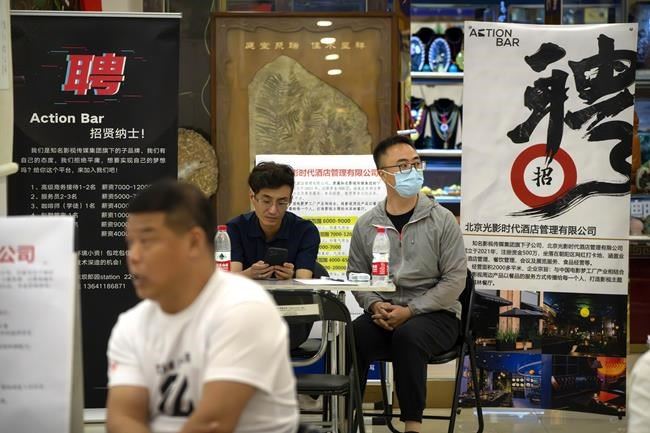뉴스&스피킹(영자신문)
하루 10분이면 영어에 대한 두려움을 극복하고 누구나 유창하게 영어를 구사하실 수 있습니다.
-
 Many Young Chinese without Jobs Move Back in with Parents An increasing number of young Chinese adults are moving back in with their parents because they cannot find jobs.
Many Young Chinese without Jobs Move Back in with Parents An increasing number of young Chinese adults are moving back in with their parents because they cannot find jobs.
Estimates show that up to one in five young Chinese are currently out of work. The situation is linked to a depressed economy and weak job market as China tried to recover from its COVID-19 policies.
Traditionally, it is not unusual for adult Chinese children to remain living with their parents and other family members in the same home. But experts say the country’s current economic conditions are forcing many young adults to move back home because they are jobless and find it hard to support themselves.
One example is 29-year-old Marguerite Wang. She moved from her family’s home in northeastern China to the southern city of Shenzhen after graduating from college.
Wang spoke to reporters from The Associated Press about her experience. She said she had enjoyed her independence and life in the city. But when she lost her job with a gaming company in December, she decided to move back in with her parents.
Wang said she spent six months actively searching for a new job in Shenzhen. When her efforts proved unsuccessful, she decided it would be best to return home. Now she spends her days watching television and studying Japanese as she prepares to seek acceptance to a master’s degree program in Japan.
Wang told the AP she now mostly spends time with her parents, who give her spending money. For the moment, she is enjoying the slower way of life back home. And she is not sure what job she wants to seek next.
“I don’t want to be in the same kind of work situation as before,” Wang said. She added that while she was employed, she did not have much of a private life. “I actually didn’t know what I was so busy for,” she said.
Government data shows the unemployment rate in Chinese cities for people aged 16 to 24 reached a high of 21.3 percent in June. In July, the Chinese government stopped publishing age-specific data, the AP reported. This led some observers to think the politically sensitive numbers had climbed even higher.
China’s economy grew at a rate of 6.3 percent in the April through June period compared to the year before. In the previous year, China was still under heavy COVID-19 restrictions. Chinese exports have also fallen sharply as other major world economies suffer slowdowns.
The country’s overall unemployment rate in cities is officially 5.3 percent. But economic experts note that young people have been more affected than others.
Over the past two years, the Chinese government has placed new rules on industries such as technology and education. The moves led to major job reductions and closures in both industries, which traditionally hire young college graduates.
Other fields such as agriculture and building are lacking enough workers. But most college graduates want less physically demanding positions.
“There are job opportunities, but the job opportunities are low quality,” said Xiang Biao. He is head of the Max Planck Institute for Social Anthropology in Germany. “So, for the only child of a family, who received education, who grew up in a so-called time of abundance, it’s very difficult to embrace that kind of job.”
The current situation also shows the changing feelings of parents, said Mu Zheng, an assistant professor of sociology at the National University of Singapore. He told the AP that parents who would push their children to succeed financially and socially might now offer to provide support to their jobless children.
Mu noted that many parents had already reached a high level of financial security after many years of economic growth. And some of those parents are now agreeing to provide the needed support to their adult family members.
I’m Bryan Lynn.View -
 Is Green Hydrogen a Truly Clean Burning Fuel? Green hydrogen has been presented around the world as a clean energy solution. But is this fuel truly clean burning? And what does it take to produce it?
Is Green Hydrogen a Truly Clean Burning Fuel? Green hydrogen has been presented around the world as a clean energy solution. But is this fuel truly clean burning? And what does it take to produce it?
What is hydrogen?
Hydrogen is the lightest chemical element. It has no color, taste, or smell, and can combine with oxygen to form water.
What is green hydrogen?
To be considered green hydrogen, the production process of separating hydrogen from other elements must be powered by renewable energy.
Hydrogen has been produced and widely used for more than 100 years, mainly to make fertilizers and plastics and to process oil. The gas has mostly been produced from fossil fuels, especially natural gas.
Industry estimates predict the worldwide market for green hydrogen could reach $410 billion by 2030. This would double its current market size.
What can green hydrogen be used for?
Green hydrogen can be used in several industries, including steelmaking, concrete production and in manufacturing chemicals and fertilizers. It can also be used to produce electricity, as a fuel for transportation and to heat homes. Supporters say green hydrogen could be used to make these processes better for the environment.
Francisco Boshell is an energy expert at the International Renewable Energy Agency in Abu Dhabi, the United Arab Emirates. He told the Associated Press (AP) that he is hopeful about green hydrogen being able to produce more clean energy. This could especially be true with energy from renewables like sun and wind power, which cannot easily be stored for later use.
Are there concerns about green hydrogen?
Boshell said one problem with hydrogen is its unpredictability. The gas is highly flammable, meaning it can easily catch fire, and requires special pipelines for safe transport. This means most green hydrogen will likely be used close to where it is produced.
The Energy Transitions Commission is a research group based in London. Its experts said in a 2021 report that, because hydrogen is highly flammable and difficult to transport, its use for heating buildings and other uses is limited. The commission is calling for net-zero emissions by 2050.
The report said hydrogen is also less effective than direct electrification methods. This is because some energy is lost when renewable resources are changed into hydrogen and then that hydrogen is changed again to power. The report suggested that the gas could be used as a way to avoid storing electricity in batteries.
Some studies have questioned the high cost of hydrogen production as well as its investment risks. There are concerns linked to a greater need for water than other clean power systems. Critics have also pointed out the lack of international guidelines that make it difficult for a worldwide market to develop.
Robert Howarth is an environmental expert and professor of environmental biology at Cornell University in New York state. He told the AP he thinks green hydrogen is being praised too much, in part because of lobbying efforts by the oil and gas industry.
But Boshell, of the International Renewable Energy Agency, disagreed. His organization has projected hydrogen demand will grow to 550 million tons by 2050. That would be up from the current 100 million tons.
The International Energy Agency says production of hydrogen is responsible for creating around 830 million tons of carbon dioxide per year. Boshell said just replacing this so-called gray hydrogen – hydrogen produced from fossil fuels – would establish a long-term market for green hydrogen.
“The first thing we have to do is start replacing the existing demand for gray hydrogen,” he said. “And then we can add additional demand and applications of green hydrogen as a fuel for industries, shipping and aviation.”
I’m Bryan Lynn.View -
_3355_1image.jpg) North Korean, Russian Leaders Meet to Discuss Military Aid North Korea wants space technology
North Korean, Russian Leaders Meet to Discuss Military Aid North Korea wants space technology
The decision to meet at the Vostochny Cosmodrome suggests Kim is seeking Russian help in developing spy satellites. In recent months, North Korea has repeatedly failed to put its first military spy satellite into orbit.
Official photos showed Kim brought Pak Thae Song, head of North Korea’s space science and technology committee, and Kim Myong Sik who is linked with spy satellites and submarine-based nuclear ballistic missile efforts.
When asked by Russian media that attended the meeting, if Russia would help Kim build satellites, Putin said: "That's why we came here."
Putin told Russian state TV that Kim will visit two more cities in the Russian Far East on his own after the meeting. Kim is expected to visit an aircraft factory in Komsomolsk-on-Amur and then go to Vladivostok to observe Russia’s Pacific Fleet, a university and other places.
I’m Mario Ritter, Jr.View -
 What Is the Goal of Japan’s New Moon Mission? Last week, Japan’s space agency launched a rocket carrying a spacecraft designed to explore the moon.
What Is the Goal of Japan’s New Moon Mission? Last week, Japan’s space agency launched a rocket carrying a spacecraft designed to explore the moon.
The lunar lander is known as the Smart Lander for Investigating the Moon (SLIM). It aims to touch down on the moon’s surface early next year. If successful, it would make Japan the fifth nation to land a spacecraft on the moon.
So far, only the United States, Russia, China and India have successfully landed spacecraft on the moon. India’s landing happened last month. India’s landing came days after Russia failed in its attempt to return to the moon for the first time in nearly 50 years.
In April, a private Japanese space exploration company announced its space vehicle crashed while trying to land on the moon. If that landing had been successful, it would have marked the first time a private business landed on the moon.
In the latest launch, an H-IIA rocket lifted off on September 7 from Tanegashima Space Center in southwestern Japan, the country’s JAXA space agency said. Hours after the launch, JAXA said it was receiving signals from the SLIM spacecraft, suggesting it was operating normally. It is expected to start the lunar landing process by February, the Reuters news agency reported.
Japanese space officials have said SLIM aims to land within 100 meters of its target area on the moon’s surface. The purpose, or mission, of the lander is to test the possibility that spacecraft can land on very specific targets.
JAXA President Hiroshi Yamakawa told a news conference the mission aims to prove that in the future, spacecraft will be able to land “where we want,” rather than only landing “where we can.”
SLIM is set to touch down in an area called Mare Nectaris, on the southeastern half of the moon. The area contains plains of solidified lava and appears as a dark area from Earth.
After landing, SLIM will seek to examine the mineral-rich rocks to search for clues about the moon’s development. The spacecraft is not carrying a lunar explorer.
SLIM is a small lander. It weighs a little more than 700 kilograms. JAXA plans to use additional light spacecraft in the future to reduce launch costs and permit more missions.
The spacecraft uses a chemical propulsion system and is equipped with very small electronic devices to control the lander. SLIM's overall development cost about $102 million.
The rocket that launched SLIM also carried the X-Ray Imaging and Spectroscopy Mission (XRISM) satellite. This part of the mission is a joint project of JAXA, the American space agency NASA and the European Space Agency.
The lander successfully separated from the rocket about 45 minutes after the launch. Ground stations in Hawaii and Japan received signals from XRISM soon after the launch. This confirmed the satellite's solar equipment had successfully deployed, JAXA said.
The XRISM satellite is designed to take images in many wavelengths of X-rays and to study the chemicals that exist in matter at high temperatures. It can gather information on the speed and makeup of what lies between galaxies. This can help scientists better understand how stars and galaxies developed. The satellite is equipped to look at X-rays of different wavelengths, or spectra, even ones at very high energy levels.
JAXA is also planning a joint lunar mission with the Indian Space Research Organization sometime after 2025. This will involve Japan's H3 rocket carrying India's next lunar lander into space.
And Japan also aims to send an astronaut to the moon's surface in the latter half of the 2020s as part of NASA's Artemis program.
I’m Bryan Lynn.View -
 Help for Gamblers as Sports Betting Rise in US People in the American state of Kentucky will be able to legally bet on sporting events for the first time in September. When they do, they also help to pay for the first-ever state program to help people with gambling problems.
Help for Gamblers as Sports Betting Rise in US People in the American state of Kentucky will be able to legally bet on sporting events for the first time in September. When they do, they also help to pay for the first-ever state program to help people with gambling problems.
Five years ago, the U.S. Supreme Court cleared the way for legalized sports betting. Almost three-fourths of U.S. states have since permitted sports betting but support for problem gambling services has been limited. Now, more states like Kentucky are requiring at least some sports gambling money to go toward helping addicted gamblers.
Research shows that younger, higher-educated men are among the most likely to bet on sports. Technology has made gambling much easier. In many states, people can now bet on smartphone apps, 24 hours a day. People can bet not only on the winners of games but on all sorts of events that happen during the game.
For the last five years, legal sports betting brought in $3 billion in taxes for local and state governments. However, the states spent little on problem gambling services.
In 2022, the state of Massachusetts budgeted $10 million for problem gambling services. And nine other states did not spend any. Most of the money from gambling went toward services like telephone helplines, counseling, and public awareness campaigns.
The federal government, which spends billions of dollars on substance abuse prevention and treatment, provides nothing for gambling problems.
Kentucky is projected to spend about $575,000 in its first year on gambling problems.
Michael R. Stone is the director of the nonprofit Kentucky Council on Problem Gambling. He said the amount of money is a good start, but “we’ve only got five certified gambling counselors in the state right now, and we’re going to need probably five times that many…”
As of a year ago, 15 states and the District of Columbia had laws requiring some of the money from sports betting to go toward problem gambling services. But another 15 states did not.
Since then, seven more states have either launched sports betting or passed laws to do so. All of those have required part of their sports betting money to go to problem gambling services, said Rachel Volberg. She is a researcher at the University of Massachusetts-Amhurst.
I’m Dan Novak.View

